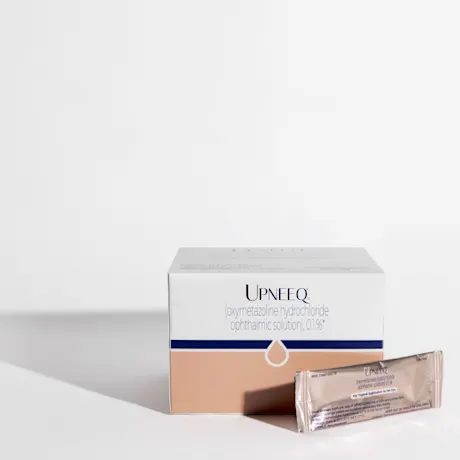

Important Safety Information for Upneeq®
What is the FDA-approved use of Upneeq?
Upneeq is a prescription eye drop used to treat acquired blepharoptosis (low-lying lids) in adults.
How should I use Upneeq?
Before administering:
Remove contact lenses. You can reinsert them 15 minutes after instilling Upneeq. If more than one medication or eye drop is being used in the eye, they should be administered at least 15 minutes apart.
Administering Upneeq:
Instill one drop of Upneeq into one or both eyes once a day. Discard the single-use container.
What should I tell my Ro-affiliated provider before using Upneeq?
Upneeq has potential drug interactions. It’s important to tell your Ro-affiliated provider all of the medications you are currently taking, including prescription, over-the-counter medications, vitamins, and herbal and dietary supplements. Some medications to watch out for include:
Medications that are used to treat high blood pressure and heart problems
Other alpha-adrenergic receptor agonists used to treat heart problems or benign prostatic hypertrophy (BPH)
MAOIs such as selegiline, isocarboxazid, phenelzine, and tranylcypromine
It’s important to share your entire medical history with your provider. In particular, tell your provider if you have a past history of:
Ptosis may be a sign of neurologic or orbital diseases such as stroke, cerebral aneurysm, Horner syndrome, myasthenia gravis, external ophthalmoplegia, orbital infection and orbital masses. It’s important to let your Ro-affiliated provider know your entire medical history so they can check if ptosis is actually a sign of other serious disease.
Heart problems
Low or high blood pressure
Issues with blood supply to the brain or heart (vascular insufficiency)
Sjögren’s syndrome
Narrow-angle glaucoma
Tell your provider if you are pregnant, planning to become pregnant, or breastfeeding. Withholding or providing inaccurate information about your health and medical history in order to obtain treatment may result in harm, including, in some cases, death.
What are the most serious side effects that I or a caregiver should monitor for when taking Upneeq?
If you are experiencing a medical emergency, call 911 or seek immediate medical attention.
These warnings and precautions are rare, but can occur with Upneeq.
Potential impacts on cardiovascular disease: Upneeq may impact blood pressure and should be used with caution if you have untreated heart problems or uncontrolled blood pressure.
Exacerbation of vascular insufficiency: Let your Ro-affiliated provider know if you have issues with blood supply to the brain or heart (vascular insufficiency), or Sjögren’s syndrome.
Risk of angle closure glaucoma: Upneeq may increase the risk of angle closure glaucoma if you have untreated narrow-angle glaucoma.
Risk of contamination: Be careful not to touch the tip of the container to your eye or to any other surface to avoid contamination.
What are the most common side effects of Upneeq?
Punctate keratitis
Conjunctival hyperemia (redness of the eye)
Dry eye
Blurred vision
Site pain when administering
Eye irritation
Headache
You are encouraged to report negative side effects of Upneeq. Contact RVL Pharmaceuticals, Inc. at 1-877-482-3788 or FDA at 1-800-FDA-1088 or www.fda.gov/medwatch. This information is not comprehensive. Please see the full Prescribing Information for complete safety information.